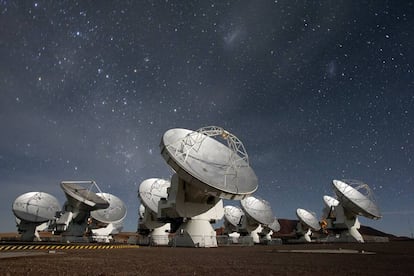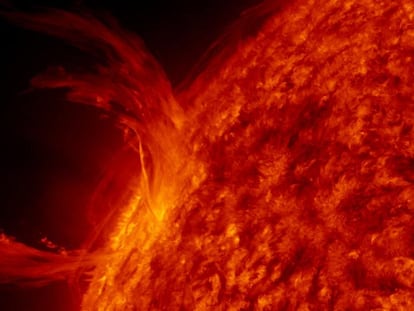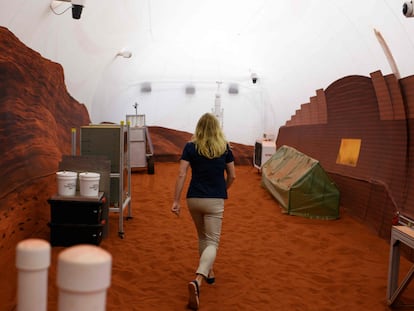First direct image of a black hole ejecting a powerful jet captured: ‘We still don’t understand how it happens’
A network of telescopes has successfully photographed matter emanating from the supermassive center of the Messier galaxy, located 55 million light-years away
For the first time, scientists have observed the powerful jet of matter ejected from a supermassive black hole in real time. This unprecedented cosmic phenomenon occurred at the center of the Messier 87 (M87) galaxy, located 55 million light-years away from our own, and was captured in 2018. This black hole became famous worldwide for being the first to be photographed.
Most galaxies harbor a supermassive black hole at their centers. Although black holes are known to gobble up everything, they can also launch powerful jets of matter that extend far beyond their galactic neighborhoods. This new image of the M87 galaxy has been reproduced thanks to an array of 14 radio telescopes located all over the Earth’s surface. This same group also successfully captured the black hole Sagittarius A* at the center of the Milky Way galaxy.
Astronomers report that this international scientific project, developed to capture these titanic galactic phenomena, helps to better understand how these mysterious gargantuan objects can launch such powerful jets. As Ru-Sen Lu of the Shanghai Astronomical Observatory in China explains in a note, “We still don’t fully understand how it happens, but we know that the jets are ejected from the region surrounding the black holes.” In order to study it directly, scientists needed to analyze the phenomenon in much greater detail than they have been able to do thus far.
Now, for the first time, the image published by the international team captures everything, showing how the matter in the jet is connected to the accretion disk rotating around the supermassive black hole. Previous research had managed to photograph this black hole at the center of M87 (which is 6.5 billion times more massive than the sun) and its jet separately but never together, until now.
The characteristic ring shape that can be seen in the image is due to the black hole ejecting matter that continues to orbit it as it heats up and emits light, which the photo then recaptures. The dark region in the center is the black hole’s shadow, which has already been imaged by the international Event Horizon Telescope (EHT) consortium.

The importance of timing and the positioning of telescopes around the world served to properly capture these astronomical objects. These include the Global mm VLBI Array (GMVA), the Atacama Large Millimeter/submillimeter Array (ALMA) and the Greenland Telescope (GLT). ALMA consists of 66 antennas in the Chilean Atacama Desert; as astronomer Lu notes, “because of its location, it was possible to reveal the black hole’s shadow and see the jet emission in greater depth at the same time.”
This time, a wavelength longer than that of the EHT made it possible “to see how the jet emerges from the emission ring around the central supermassive black hole,” explains Thomas Krichbaum, of the Max Planck Institute for Radio Astronomy, in a note from the European Southern Observatory. In the new results provided by the GMVA telescope network, astrophysicists point out that the image of the black hole is 50% larger and thicker than the one taken by the 2018 EHT, suggesting that there is more material falling than could be detected at the time.
In the future, the work of the telescope network is far from over. Scientist Eduardo Ros, also from the Max Planck Institute for Radio Astronomy, explains that his team plans to continue observing “the region around the black hole at the center of M87, at different radio wavelengths, to further study the jet emission.” The astronomer anticipates more discoveries: “The next few years will be exciting, since we will be able to learn more about what is happening near one of the universe’s most mysterious regions.”
Sign up for our weekly newsletter to get more English-language news coverage from EL PAÍS USA Edition
Tu suscripción se está usando en otro dispositivo
¿Quieres añadir otro usuario a tu suscripción?
Si continúas leyendo en este dispositivo, no se podrá leer en el otro.
FlechaTu suscripción se está usando en otro dispositivo y solo puedes acceder a EL PAÍS desde un dispositivo a la vez.
Si quieres compartir tu cuenta, cambia tu suscripción a la modalidad Premium, así podrás añadir otro usuario. Cada uno accederá con su propia cuenta de email, lo que os permitirá personalizar vuestra experiencia en EL PAÍS.
¿Tienes una suscripción de empresa? Accede aquí para contratar más cuentas.
En el caso de no saber quién está usando tu cuenta, te recomendamos cambiar tu contraseña aquí.
Si decides continuar compartiendo tu cuenta, este mensaje se mostrará en tu dispositivo y en el de la otra persona que está usando tu cuenta de forma indefinida, afectando a tu experiencia de lectura. Puedes consultar aquí los términos y condiciones de la suscripción digital.
More information
Últimas noticias
NASA discovers Titan doesn’t have an ocean, but a ‘slushy ice layer’ that increases possibility of life
Innocence lost in the forest of the child soldiers: ‘Each leader of the armed group had his girls’
‘Fallout’ or how the world’s largest company turned an anti-capitalist apocalyptic Western into a phenomenon
From inflation to defending migrants: Eileen Higgins and Zohran Mamdani inaugurate the new Democratic resistance against Trump
Most viewed
- ‘El Limones’ and the growing union disguise of Mexican organized crime
- Christian Louboutin: ‘Young people don’t want to be like their parents. And if their parents wear sneakers, they’re going to look for something else’
- The low-cost creative revolution: How technology is making art accessible to everyone
- ‘We are dying’: Cuba sinks into a health crisis amid medicine shortages and misdiagnosis
- Liset Menéndez de la Prida, neuroscientist: ‘It’s not normal to constantly seek pleasure; it’s important to be bored, to be calm’











































